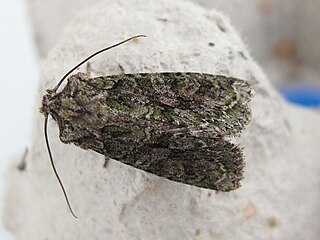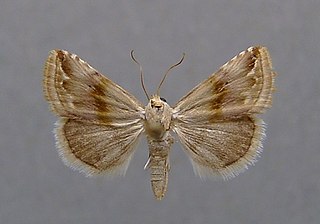
The pine beauty is a moth of the family Noctuidae. It is a common species of pine woods in Europe. The distribution area extends from Portugal to western Siberia, the Caucasus and Asia Minor. In the north it extends to the Arctic Circle, in the south it is found in Ceuta in Northern Africa in and southern Italy.

The chalkhill blue is a butterfly in the family Lycaenidae. It is a small butterfly that can be found throughout the Palearctic realm, where it occurs primarily in grasslands rich in chalk. Males have a pale blue colour, while females are brown. Both have chequered fringes around their wings.

Bibasis gomata, commonly known as the pale green awlet, is a butterfly belonging to the family Hesperiidae. It is found in Northeast India, the Western Ghats and parts of Southeast Asia. The butterfly was reassigned to genus Burara by Vane-Wright and de Jong (2003) and is considered by them to be Burara gomata.

Curetis thetis, the Indian sunbeam, is a species of lycaenid or red butterfly found in Indomalayan realm.

Appias libythea, the striped albatross, is a small butterfly of the family Pieridae, that is, the yellows and whites, which is found in south and southeast Asia.

Daphnis nerii, the oleander hawk-moth or army green moth, is a moth of the family Sphingidae. It was described by Carl Linnaeus in his 1758 10th edition of Systema Naturae.

Bibasis harisa, the orange awlet, is a species of hesperid found in Asia. The butterfly was reassigned to genus Burara by Vane-Wright and de Jong (2003) and is considered by them to be Burara harisa.
Schistonoeidae is a monotypic moth family, described by Ronald W. Hodges in 1998, in the superfamily Gelechioidea. It contains one monotypic genus, Schistonoea, described by William Trowbridge Merrifield Forbes in 1931. Its one species, Schistonoea fulvidella, described by Lord Walsingham in 1897, is found in the West Indies.

Colias palaeno, known by the common names moorland clouded yellow, palaeno sulphur, and pale Arctic clouded yellow, is a butterfly in the family Pieridae.

Atethmia centrago, the centre-barred sallow, is a moth of the family Noctuidae. The species was first described by Adrian Hardy Haworth in 1809. It is found in Europe except Scandinavia and Italy; also in Asia Minor, Armenia, Syria and Palestine.

Anthophila fabriciana, also known as the common nettle-tap, is a moth of the family Choreutidae first described in 1767 by Carl Linnaeus. The moth can be found flying around stinging nettles during the day.

Carcina quercana is a species of moth of the family Depressariidae. It is found in Europe. It has been introduced recently in North America, British Columbia and western Washington. It is occasionally known by several common names including oak lantern, long-horned flat-body, and oak-skeletonizer moth.

Dryobotodes eremita, the brindled green, is a moth of the family Noctuidae. The species was first described by Johan Christian Fabricius in 1775. It is found in most of Europe, east to Turkey.

Eublemma ostrina, the purple marbled, is a moth of the family Erebidae. The species was first described by Jacob Hübner in 1808. It is mainly found in central and southern Europe, and further east, but is also a scarce migrant in the United Kingdom, where it is mainly found along the south coast.
Durrantia is a moth genus of the family Depressariidae.
Durrantia piperatella is a moth in the family Depressariidae. It was described by Philipp Christoph Zeller in 1873. It is found in North America, where it has been recorded from Arkansas, Louisiana, Mississippi and Texas.
Durrantia arcanella is a moth in the family Depressariidae. It was described by August Busck in 1912. It is found in Mexico, Panama, Guatemala, Honduras and Venezuela.
Durrantia resurgens is a moth in the family Depressariidae. It was described by Lord Walsingham in 1912. It is found in Mexico and Guatemala.
Durrantia pugnax is a moth in the family Depressariidae. It was described by Lord Walsingham in 1912. It is found in Panama, Guatemala and Venezuela.
Durrantia flaccescens is a moth in the family Depressariidae. It was described by Edward Meyrick in 1925. It is found in Peru and Venezuela.












